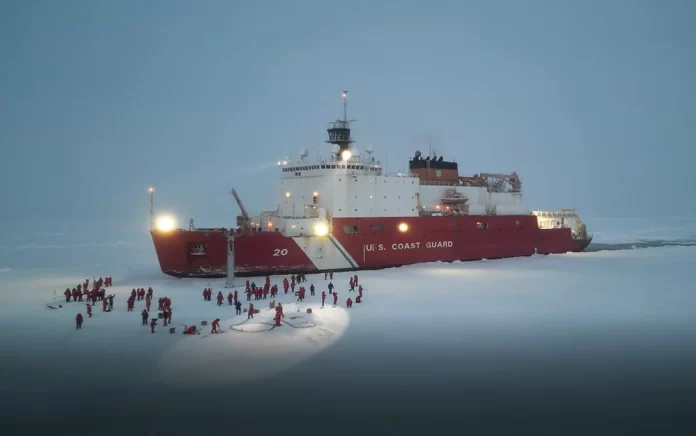In the Arctic, warming temperatures and melting sea ice have opened new shipping routes but have also increased climate risks and international economic competition. Addressing these issues is a strategic priority for the U.S. government.
By virtue of Alaska, the United States is an Arctic nation and consequently has substantial interests in the region. As the Arctic warms twice as rapidly as the rest of the world, the effects of climate change have driven increasing interest and activity in the region in recent years and these climate effects have been far-reaching. Reports have documented the global implications of the widespread changes occurring in the Arctic. For example, scientists at Department of Energy’s Pacific Northwest National Laboratory found that declines in Arctic sea ice during the summer months are linked to increases in autumn wildfires over the western United States.
In addition, there has been an escalation of great power competition between the U.S., Russia, and China, which seeks Arctic resources, among other things. Both Russia and China have developed Arctic strategies with geopolitical goals contrary to U.S. interests. According to the U.S. Army’s Arctic strategy, Russia seeks to consolidate sovereign claims and control access to the region while China aims to gain access to Arctic resources and sea routes to secure and bolster its military, economic, and scientific rise.
In September 2022 and August 2023, the U.S. monitored Chinese and Russian military vessels conducting joint exercises off the coast of Alaska in the Bering Sea and near the Aleutian Islands, respectively. These activities have introduced tension into the Arctic’s geopolitical environment.
In October 2022, the federal government published an updated Arctic strategy that serves as a framework for guiding its approach to addressing emerging challenges and opportunities in the Arctic. The strategy identified four priorities spanning domestic and international issues: security, climate change and environmental protection, sustainable economic development, and international cooperation and governance.
While many federal entities engage with foreign partners on Arctic issues, the Department of State serves as the lead for Arctic diplomacy efforts. The Biden administration announced that an existing Arctic coordinator position at State would be elevated to an Ambassador-at-Large position in August 2022, but the nominee has yet to be confirmed. State Department officials told a Government Accountability Office (GAO) review earlier this month that discussions regarding the new position are continuing internally and that the department is in the process of developing the final details of the Ambassador’s role. The officials said the Ambassador position will be located in the Office of the Secretary, and will report to the Secretary or the Secretary’s designee.
U.S. and foreign stakeholders have previously identified factors that may help advance U.S. priorities, such as creating the Ambassador position, as well as providing scientific and other expertise at the Arctic Council—a forum that promotes cooperation among Arctic countries. But GAO found that challenges in interagency coordination and other areas may make some U.S. priorities harder to achieve.
Stakeholders told GAO of five factors that facilitate and five factors that hinder the federal government’s management of U.S. Arctic priorities. For example, stakeholders identified U.S. Arctic expertise and engagement as factors that facilitated its influence in the Arctic Council. However, some stakeholders said that the Arctic Executive Steering Committee and the broader federal government face various challenges related to interagency coordination that hinder implementation of U.S. Arctic priorities outlined in the 2022 strategy. They added that limited engagement with Alaskans, coordination obstacles, and budget uncertainties also impact efforts.
The stakeholders identified three factors pertaining to State’s structures that facilitated and two factors that hindered State’s management of U.S. Arctic priorities. For example, stakeholders identified continuity within the Senior Arctic Official position and supporting office as a factor that has deepened institutional knowledge for Arctic Council work, facilitating efforts to promote U.S. priorities. However, some stakeholders identified gaps in leadership and limited convening authority as factors that had hindered management. Many stakeholders viewed the announcement of the Ambassador-at-Large for the Arctic Region position positively but identified elements State and the new Ambassador should consider to manage U.S. Arctic priorities successfully going forward. These elements include consistency in position and title, a formalized office structure, clarity of Ambassador’s role within the department, and greater authority to coordinate with all the relevant bureaus across the department.
In their discussions with GAO, some stakeholders questioned Americans’ awareness of Arctic issues and said that the U.S. government and public may need a greater appreciation of the region to fully support the implementation of the Arctic Strategy. One also questioned the federal government’s understanding of the region, noting that some federal agencies with regional offices that cover Alaska are based in Denver or elsewhere. However, other stakeholders noted that recent increased attention to Arctic issues from policymakers and federal entities has been helpful. For example, one of these stakeholders said that attention from the White House and the Senate has helped to advance the U.S. Coast Guard’s Polar Security Cutter Program, which will enable the United States to increase its maritime presence in the Arctic.






